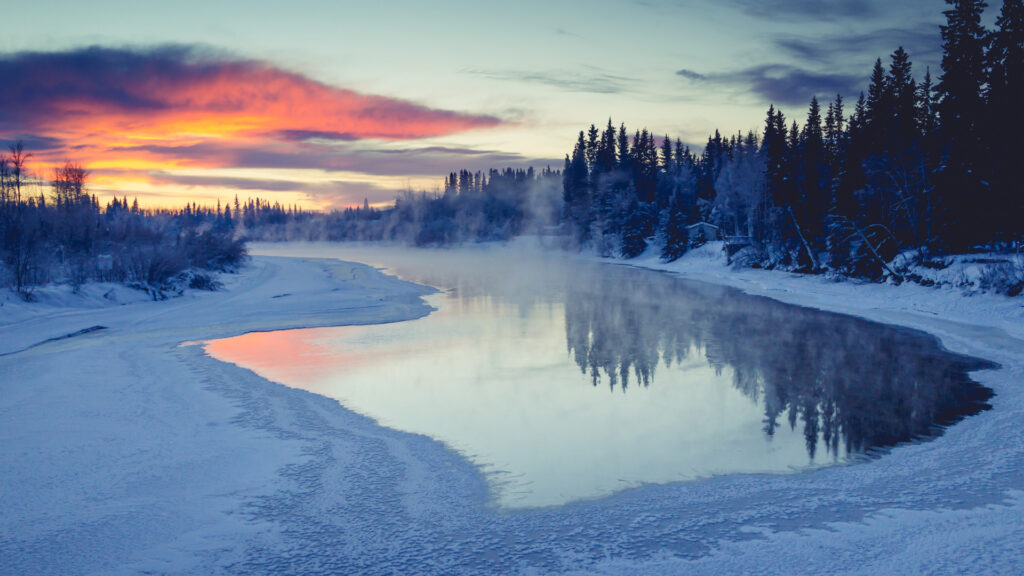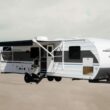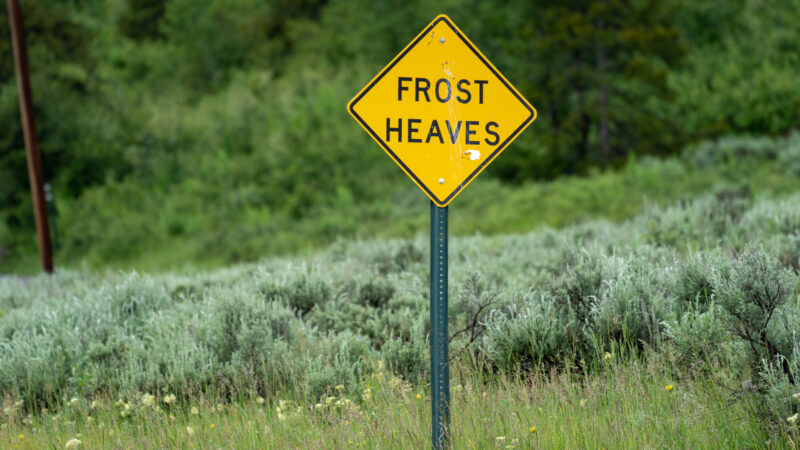Table of Contents Show
The first time we heard about frost heaves was while preparing for our big adventure to Alaska. It didn’t take us long to realize we needed to take them seriously.
You must prepare for them if you have hopes of exploring The Last Frontier. If not, you could find yourself in a dangerous situation.
Today, we’re sharing about frost heaves and why RVers need to know about them. Buckle up, and let’s get started!
What Is a Frost Heave?
A frost heave happens when groundwater or earth freezes and expands, pushing up the surface.
This typically occurs in cold climates. The ground shifts upward with an intense amount of force. Unfortunately, it moves just about anything in its path.
If you’re bringing your RV, be mindful of frost heaves. They impact roads, sidewalks, home foundations, and campsites. This can make it very challenging to get your camper level and stable.
What Causes Frost Heaves in Roads?
Frost heaves occur when moisture in the ground freezes. As you’ve likely experienced, water expands as it freezes.
When this happens in the ground, it creates layers of frozen ground and pushes the surface upward. This heaving leaves a raised area or uneven ground surface, including pavement.
Unfortunately, frost heaves can be incredibly dangerous. They pose a tripping hazard while navigating trails and walkways and can damage your vehicle. If you think the roads are terrible where you live, wait until you experience Alaska. Some of the potholes are so large they deserve their own zip code.
How Cold Does It Have to Be for a Frost Heave?
Winters in Alaska are extreme. Frost heaves can occur anytime the temperature dips below freezing, but they don’t always happen. It significantly depends on the amount of moisture and the soil’s composition.
Ideal conditions for them to form involve multiple freezing and thawing cycles. The more cycles, the more extreme the heaves become.

Navigating frost heaves in an RV can be tricky. However, we learned a few things during our trip that can help you conquer them.
Slow Down
Trying to fly through an area populated by frost heaves can be dangerous. Don’t believe us? Just watch the cars in this video.
While it may take a bit longer to get there, it’ll be worth it. Many of the drivers in the video lost control of their vehicles. Going slow gives you time to respond to the changes in the road and minimizes stress on your RV.
As this driver demonstrates, it’s a much less dramatic experience.
Maintain a Steady Grip on the Steering Wheel
It’s vital to maintain both hands firmly on the wheel. This will help you control the vehicle as you navigate the rough terrain. You’ll likely need to adjust to maintain stability and your lane.
Make corrections as smoothly as possible. This can help you avoid overreacting. When this occurs, you could launch yourself into the oncoming lane or off the side of the road.
While we don’t have first-hand experience, we can assure you that neither is a great option.
Keep in Mind: Before driving on a washboard road, read these tips on How to Safely Drive on a Washboard Road!
Avoid Sudden Braking
It’s natural to press the brakes in these situations. However, stomping on the brakes can be dangerous. The quick shift in momentum can increase the bouncing and swaying you feel. This can make it challenging to maintain control and traction for your vehicle.
Instead of a sudden brake, a gradual and more controlled approach is the better option. This lets your tires maintain grip and minimizes wear and tear on your suspension.
In addition, your passengers will likely find this more comfortable than slamming into their seatbelts.
Keep Your Distance
If you think back to when you took driver’s education, you likely learned the three-second rule. Following this rule helps ensure enough space between you and any vehicle in front of you. If you stopped following this rule shortly after getting your driver’s license, it’s time to revisit it.
Keeping your distance allows you to adjust based on observations of the vehicle ahead of you. When you see their car bouncing like a kid on a trampoline, you can know you’re approaching a frost heave.
This simple adjustment can help you avoid slamming into the car in front and see any road obstructions.

Watch for Signs or Flags
If you’re lucky, signs or flags will warn you of frost heaves. These are typically yellow or bright orange with black lettering. Their simple “frost heaves” message communicates all you need to know. Sometimes, locals install homemade signs to help travelers and others unfamiliar with the area avoid a disaster.
You need to keep your eyes on the road because you never know when frost heaves will occur. Watch for the signs and flags, but don’t depend on them. There’s a good chance there won’t be a flag or sign for every heave in the road.
Unfortunately, driving can feel like a game of hide and seek. They’re hiding, and you’ll know when you find them.
Keep in Mind: Wildfire season is just around the corner. If you’re going camping this fall, here’s How to Prepare for Wildfire Season in Your RV
Avoid Driving at Night
Driving at night can be incredibly dangerous. For one, this is when the massive wildlife is more likely to wander into the road. And the darkness makes seeing the enormous frost heaves even harder.
They’ll sneak up on you, especially if you don’t see the flags or signs. This is one surprise you won’t enjoy.

Report Hazardous Conditions
Sometimes, the only thing you can do is to report hazardous conditions. Unfortunately, these road conditions are unavoidable in some parts. Repairing the roads requires a massive amount of workers and resources.
Sadly, fixing every road just isn’t possible. In many instances, these heaves can return. By reporting the hazardous conditions, officials will likely install warning signs or flags to help alert future drivers. This may be all that’s necessary to help others avoid a dangerous situation.
While frost heaves may not be just an ordinary bump in the road, you can navigate them safely. Apply the tips we shared today, and you’ll drive these frozen roads like a seasoned veteran.
Whether you’re going to Alaska or some other tundra, drive safe and enjoy the adventure!






